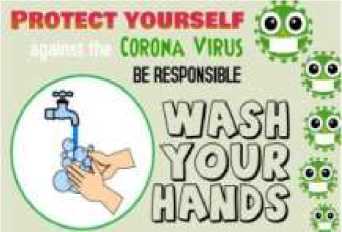Discovering Messages in COVID-19 Advertisements: A Semiotic Analysis
on
https://ojs.unud.ac.id/index.php/linguistika/
DOI: https://doi.org/10.24843/ling.2021.v28.i02.p04
LINGUISTIKA, SEPTEMBER 2021
p-ISSN: 0854-9613 e-ISSN: 2656-6419
Vol. 28 No.2
Discovering Messages in COVID-19 Advertisements: A Semiotic Analysis
Ni Putu Adik Mariani, Desak Putu Eka Pratiwi, I Wayan Juniartha Mahasaraswati Denpasar University, Bali
Adikmariani02@gmail.com, desak.eka.pratiwi@gmail.com, r_juniartha@gmail.com
Abstract—COVID-19 advertisement is a kind of advertisement which used to convey the information about COVID-19 as well as instructions regarding to health protocols to avoid us from the danger of COVID-19. This study concerned on finding out the messages carried by both verbal and nonverbal signs in COVID-19 advertisements. The data were taken from Pinterest. The data were collected by observation method. The collected data were analyzed by qualitative method using theory of semiotics from Saussure (1983), the theory of meaning from Barthes (1977), and theory of color term from Wierzbicka (1996). The message is presented in formal and informal way. Our findings show that verbal and nonverbal cues in advertisements generally convey the messages that during the pandemic people have to obey protocols such as staying at home, wearing masks correctly, keep social distancing, and washing hands.
Keywords: Semiotics, sign, verbal, non-verbal, COVID-19 advertisement
Abstrak-- Iklan COVID-19 adalah salah satu jenis iklan yang digunakan untuk menyampaikan informasi tentang COVID-19 serta petunjuk tentang tata cara kesehatan agar kita terhindar dari bahaya COVID-19. Penelitian ini bertujuan untuk mengetahui pesan yang dibawa oleh tanda verbal dan nonverbal dalam iklan COVID-19. Data diambil dari Pinterest. Pengumpulan data dilakukan dengan metode observasi. Data yang terkumpul dianalisis dengan metode kualitatif menggunakan teori semiotika dari Saussure (1983), teori makna dari Barthes (1977), dan teori warna dari Wierzbicka (1996). Temuan kami menunjukkan bahwa tanda verbal dan nonverbal dalam iklan umumnya menyampaikan pesan bahwa selama pandemi semua orang harus mematuhi protokol kesehatan seperti diam di rumah, memakai masker dengan benar, menjaga jarak dan selalu mencuci tangan.
Kata Kunci— Semiotika, tanda, verbal, non-verbal, COVID-19 advertisement
Vol. 28 No.2
-
1. Introduction
Language is a sign system used as a tool of human communication in daily life. Everything in our live is bound by language. Language as a sign means that language interprets sign in a communication process. In interpreting into a language, the most important thing to know is the meaning of the signs. The concept of this signs is to see the meaning appears when there is a relationship between (signified) and (signifier).
Semiotic is the study of sign or the science that study about sign in human being. Semiotics concerned with everything that can be taken as a sign and we would give the meaning. Semiotic learn how human interpret thing around them. Picture, signs, symbols and color surround us all, whether they are verbal and nonverbal sign. Sign found in the advertisement which is used to represent an object and persuade people to give attention and read the advertisement.
Advertisements contain notification to the public with a purpose to influence the readers to do what they want. Advertising is not limited to products but also information or a call to do something. Regular advertisements are promoted through advertising media such as television, radio, newspapers, magazine, and the internet. In the advertisements there are verbal and nonverbal signs which designed attractively to attract people attention.
Public service advertisements are short messages that are generated in images, audio or video and then displayed on billboards, radio stations, television or other media. Public service advertisements are generally designed to convey messages in the form of educational information, instead of promoting a product or service. One example of public service advertisements is COVID-19 advertisement. The language used in COVID-19 advertisements generally have the aim to attract attention and to get people take an action. They are also used to convey the information about COVID-19 as well as instructions regarding to health protocols to avoid us from the danger of COVID-19 virus.
Through this analysis the writer tries to analyze the meaning of verbal and nonverbal signs in COVID-19 advertisements. By identifying the meaning of the verbal and nonverbal signs in the advertisements, it can help the people to understand the implied messages delivered by COVID-19 advertisements.
-
2. Material and method
The data were taken from COVID-19 advertisements which downloaded from the Pinterest created by Freepik and VectorStock. There are five advertisements used in this analysis entitled (a) Stay Home; (b) Use Masks, (c) Keep Social Distancing, (d) Do It Right, and (e) Protect Yourself. The data were collected through observation method by searching and downloading the advertisements, reading the advertisements repeatedly, and note taking. The writer used two main theories and one supporting theory to analyze the collected data. Theory of Semiotics proposed by Saussure (1983) and Barthes (1977) are used to analyze the meaning of verbal and visual signs. The theory of color proposed by Wierzbicka (1996) is also used as the supporting theory. The findings are presented in informal method.
-
3. Result and Discussion
COVID-19 advertisements were analyzed based on Saussure’s Semiotic theory as well as the theory of meaning by Barthes (1977). COVID-19 advertisements consist of verbal and nonverbal signs. The verbal signs consist of words and sentences. Meanwhile nonverbal signs are in form of figures, images and colors.
3.1 Advertisement 1: “Stay Home”

Figure 1. Stay Home Advertisements (Source: pinterest.com)
Vol. 28 No.2
-
3. 2 Advertisement 2: “Use Masks”
In this advertisement, there only one verbal sign. The verbal sign in this advertisement is “stay home save a life”. This statement aims to tell the readers to always stay at home and not to visit public places if don't have significant business. COVID-19 is spread through droplets, cough, sneezes, and furthermore through the air. These verbal signs remind us to consistently remain at home and reduce outdoor activities, working from home and worshiping from home in order to stop the spread of coronavirus.
It implicitly delivers some messages for readers. The fewer people you are around, the lower your chance of infection. When you stay home, you help stop the spread to others, too. Do not go to crowded places. If your community is under shelter-in-place orders, follow proper guidelines for when you can leave your home. Keep a stock of supplies like food and medicine, so you can hunker down when you need to.
This advertisement uses black color as the background. Color is the main part of the advertisements. Concerning the nonverbal sign, the use of particular color in a notice should have the correct blend with verbal sign in the promotion. Color has the ability to pass on and convey implications and messages without utilizing words. According Wierzbicka (1996), the black color is associated with power, elegance, formality, death, evil, and mystery. Black color in this advertisement is used to emphasize the theme of this advertisement and also to represent death. Black color connected with death which represents the effect of coronavirus which is dangerous for people and can cause death.
The last nonverbal sign is the picture of the virus which is in green color which represents COVID-19. According to Wierzbicka (1996: 307) green color can indicate sickness, cowardice and discord. The significance of the green color in the advertisement is to represent illness in relation to the subject of this advertisement, since it is closely related to the COVID-19 virus.

Figure 2. Use Masks Advertisements (Source: pinterest.com)
The first verbal sign is “Always use masks and keep it clean”. This statement aims to tell the people to always wear mask. Wearing a mask will prevent the spread of COVID-19. Therefore, to avoid the transmission of viruses, we do need to use masks. The message is that masks should be used as part of a comprehensive strategy of measures to suppress transmission and save lives. The use of a mask alone is not sufficient to provide an adequate level of protection against COVID-19. If COVID-19 is spreading in your community, stay safe by taking some simple precautions, such as physical distancing, keeping rooms well ventilated, avoiding crowds, cleaning your hands, and coughing into a bent elbow or tissue. We have to do it all.
Make wearing a mask a normal part of being around other people. The advertisement emphasized that we have to keep the masks clean. The appropriate use, storage and cleaning or disposal of masks are essential to make them as effective as possible. Here are the basics of how to to keep masks clean: clean your hands before you put your mask on, as well as before and after you take it off, and after you touch it at any time. When you take off a mask, store it in a clean plastic bag, and every day either wash it if it’s a fabric mask, or dispose of a medical mask in a trash bin. Don’t use masks with valves. If our masks are dirty, it will not be able to protect us from the virus.
The first nonverbal sign is the blue color as the background. According to Wierzbicka (1996: 310) blue is a color that used to describe health, healing, calm, understanding and softness. In addition, blue represents
Vol. 28 No.2
both the sky and the sea, and is associated with open spaces, freedom, intuition, imagination, expansiveness, inspiration, and sensitivity. The blue color communicates significance, importance, and confidence. In this advertisement, it is used to highlight the message that it is very important to wear masks in this pandemic and your action has significant impact to save yourself and people around you.
Another nonverbal sign in this advertisement is the picture of the earth wearing a mask. It has two hands, one hand holding a bottle of hand sanitizer and another one shows a thumb up. The earth shows that the pandemic is a global health issue. It happens all around the planet so that this advertisement encourages all people all around the world to protect the earth by wearing masks and use hand sanitizer anytime. It carries a message that you have to do these two basic self-protections since by protecting yourself, you protect others as well. By protecting others, you protect the world. You do a great job just by doing these simple self-protections every single day.
-
3.3 Advertisement 3: “Social Distancing”

Figure 3. Social Distancing 6 Feet Away Advertisement (Source:pinterest.com)
The first verbal sign is “Social Distancing 6 Feet Away”. These verbal sign aims to tell the reader to always do social distancing in public area. Maintaining a physical distance from other individuals may prevent the virus from spreading from one person to another. Maintaining physical distance, however, does not mean that our social ties with our loved ones or families are cut off.
This advertisement tries to give education for the readers especially about social distancing. Social distancing, also called “physical distancing,” means keeping a safe space between yourself and other people who are not from your household. Limiting close face-to-face contact with others is the best way to reduce the spread of coronavirus disease (COVID-19). To practice social or physical distancing, stay at least 6 feet (about 2 arm lengths) from other people who are not from your household in both indoor and outdoor spaces.
In addition, the advertisement implicitly reminds people that COVID-19 spreads mainly among people who are in close contact (within about 6 feet) for a prolonged period. Spread happens when an infected person coughs, sneezes, or talks, and droplets from their mouth or nose are launched into the air and land in the mouths or noses of people nearby. The droplets can also be inhaled into the lungs. Recent studies indicate that people who are infected but do not have symptoms likely also play a role in the spread of COVID-19. Since people can spread the virus before they know they are sick, it is important to stay at least 6 feet away from others when possible, even if you or they do not have any symptoms. Social distancing is especially important for people who are at higher risk for severe illness from COVID-19.
The nonverbal signs seen from the advertisements are two people standing and greeting each other from distance by waving their hands. It shows that people have to keep their distance in communicating. It delivers a message that in this pandemic we have to obey government regulation to stay in distance with others. It is still possible to stay socially connected with friends and family who do not live in your home by calling, using video chat, or staying connected through social media. If meeting others in person (e.g., at small outdoor gatherings, yard or driveway gathering with a small group of friends or family members), stay at least 6 feet from others who are not from your household.
Vol. 28 No.2
In this advertisement, there are two combinations of colors which are blue and white as the background. According to Wierzbicka (1996: 310) blue is a color that used to describe health, healing, calm, understanding and softness. While white, an inherently positive color, is associated with purity, safety, cleanliness, sterility, possibility, humility, sincerity, protection, and perfection. These colors have implied message. Blue represents the idea that health is the most important issue nowadays, we have to stay healthy by doing all the health protocols. White particularly represents the concepts of safety, cleanliness, sterility, and protection. It shows that self-protection and safety are our own responsibility by understanding the importance of cleanliness and sterility to keep us safe and protected from COVID-19.
3.4 Advertisement 4: “Do It Right’

Figure 4 Do It Right Advertisement (source: pinterest.com)
The first verbal sign in this advertisement is “Do It Right”. It aims to invite the readers to always wear mask properly. These verbal signs have a message that in fact some people do not aware how to wear masks correctly. Masks are a critical step to help prevent people from getting and spreading COVID-19. It is important to inform the correct way wearing masks through this advertisement since it is useless to wear masks if it is not done in a correct way. The correct ways wearing a mask are: put the mask over your nose and mouth and secure it under your chin; fit the mask snugly against the sides of your face, slipping the loops over your ears or tying the strings behind your head; make sure you can breathe easily.
The second verbal sign is “Don’t Touch Your Mask”. This statement means that we cannot touch our
masks with our hands since during our activities, we touch many objects by our hands. If we touch our masks with dirty hands, the virus will stick on the mask and can be inhaled, which is dangerous for our health. These verbal signs have implied message. It encourages people to wash hands or use hand sanitizer before putting on a mask to keep it clean and safe to wear.
The third verbal sign is “Wash After Use”. This verbal sign means that we have to wash the mask after using it to kill the virus or bacteria which stick on it. We have to get used to wash masks especially the fabric masks. It delivers a message that we have to pay attention to the cleanliness of things around us to avoid virus since this new type of corona virus can survive on the surface of the clothes or masks.
The fourth verbal sign is “Cover Nose + Mouth”. These verbal signs show the correct ways wearing masks. Masks are very important to cover the nose and mouth and fit under the chin. Most people wear mask only to cover their mouth, while their nose is left uncovered. The nose is very susceptible to COVID-19 infection since it is the main route of the virus to get into our body. These verbal signs send a beneficial message to make people know and understand how to wear a mask correctly and effectively.
The first nonverbal sign in this advertisement is a girl wearing a white mask. This nonverbal sign is used to represent self-protection. It implies a message that we have to protect ourselves by always wearing a mask since COVID-19 spreads mainly from person to person through respiratory droplets. Respiratory droplets travel into the air when you cough, sneeze, talk, shout, or sing. These droplets can then land in the mouths or noses of people who are near you or they may breathe these droplets in. Masks are a simple barrier to help prevent your respiratory droplets from reaching others. Studies show that masks reduce the spray of droplets when worn over the nose and mouth.
The second nonverbal signs are pictures of three people wearing masks at the bottom of advertisement. These pictures show the incorrect way people wearing masks. The first picture shows somebody wears a mask which only covers his mouth.
Vol. 28 No.2
The second picture shows somebody wears a mask which covers his eyes. The third picture shows somebody wears a mask and touches his mask. These three pictures are an implicit warning that you should not do that if you wanted to protect yourself from the virus. Masks should completely cover the nose and mouth and fit snugly against the sides of face without gaps. Another important point is that a mask is not a substitute for social distancing. Masks should still be worn in addition to staying at least 6 feet apart, especially when indoors around people who do not live in your household.
The last nonverbal sign is the color of the background. The green color on the background is closely related with the theme of the advertisement, which to tell the effect of the coronavirus. Green color can indicate sickness, cowardice, and discord. Because of that reason, this advertisement uses green color as the color of the background to represent sickness if we are exposed to this virus.
3.5 Advertisements 5: “Protect Yourself”

Figure 5 Wash Your Hands Advertisement (Source: pinterest.com)
The first verbal sign in the advertisement is “Protect yourself against the corona virus”. The aim of this verbal sign is to tell the readers to always protect themselves from the spread of COVID-19 virus. There are some ways to protect ourselves from COVID-19 virus, such as wearing a mask in a public place; keeping 1 meter distance from each other; avoiding crowded places; washing hands; not touching our eyes, nose and mouth; maintaining personal and environment hygiene; and having healthy food. In this advertisement “wash your hands” is highlighted so that the words
are written in a big font size to make it eyecatching.
The second verbal sign in the advertisement is “Be responsible”. The meaning of this verbal sign is to remind the readers to always be responsible for their health and other people around them. As we know, this pandemic has occurred in all countries all around the world. This kind of situation is something new and we must fight together. This pandemic has caused many casualties, as well as paralyzed other sectors of the economy and life. Fighting this virus is our collective responsibility, not only the responsibility of the government or the medical workers. Our awareness in following health protocols is a kind of our responsibility in fighting the spread of COVID-19 virus.
The last verbal sign in the advertisement is “Wash your hands”. The meaning of this verbal sign is to tell the readers to always wash their hands. Keeping our hands clean is one of the most effective ways to prevent the spread of COVID-19. After doing some activities and touching many objects, we have to wash our hands with soap and water for at least 20 seconds. If the water is not available you can use hand sanitizer with at least 70% level of alcohol. We should also remember to wash our hands before and after preparing food and eating, after using toilet, coughing, and sneezing.
The first nonverbal sign in this advertisement is the red font color which emphasize the title of the advertisement “Protect yourself”. Wierzbicka (1996: 315) declares that red is “a rich warm color” because it is associated with fire, when people are asked about which color makes them think of fire, many of them reply “red”. The advertisement warns people how important it is to always protect themselves, in order to avoid and stop the spread of coronavirus.
The second nonverbal sign in this advertisement is green font color of the words “corona virus” and also the green color of the virus pictures. Green color is used to represent COVID-19 virus. Green color indicates sickness.
Vol. 28 No.2
The last nonverbal sign in this advertisement is a picture of somebody washing hands. It shows that you should wash your hands for at least 20-30 seconds. In addition, it reminds the readers to wash hands at the following times: after blowing your nose, coughing or sneezing; after visiting a public space, including public transportation, markets and places of worship; after touching surfaces outside of the home, including money; before, during and after caring for a sick person; before and after eating. This is the main message of the advertisement. This picture implicitly tells the readers that during a global pandemic, one of the cheapest, easiest, and most important ways to prevent the spread of a virus is to wash your hands frequently with soap and running water.
-
4. Conclusion
Based on the discussion above it can be concluded that the COVID-19 advertisements generally deliver a message that people can defeat and prevent the spread of corona virus by following government regulation and obey the health protocol. By the analyzing the verbal and nonverbal signs used in the advertisements above, it can be concluded that the COVID-19 advertisements have various massages. First, the advertisement tells the readers to stay at home and reduce outdoor activities, working from home and worshiping from home in order to stop the spread of coronavirus. Second, it reminds people to make wearing a mask a normal part of being around other people. The appropriate use, storage and cleaning or disposal of masks are essential to make them as effective as possible. Third, the advertisement delivers a message about the importance of social distancing, which also called “physical distancing”. Limiting close face-to-face contact with others is the best way to reduce the spread of coronavirus disease (COVID-19). Fourth, the advertisement invites the readers to always wear mask properly to make it more effective in preventing the virus infection. Fifth, the advertisement tells people to protect themselves against the corona virus since this is our collective responsibility, not only the responsibility of the
government or the medical workers. Our awareness in following health protocols is a kind of our responsibility in fighting the spread of COVID-19 virus. All these messages are very beneficial for readers to be more aware and responsible in facing this pandemic. In addition, these advertisements educate and encourage people to do their part in defeating COVID-19.
Vol. 28 No.2
References
Barthes, R. 1977. Elements of Semiology.Hil and Wang, New York: A Division of Farrar, Straus and Giroux.
Barthes, R. 1998. The Semiotics Challenge. New York: Hill and Wang.
Barthes, R. 2009. Mythologies. London: Vintage.
Barthes, R. 2007. Petualangan Semiologi. Yogyakarta: Pustaka Pelajar.
Chandler, D. 2007. The Basic Semiotics. New York: Routledge.
Dyer, G. 1993. Advertising as Communication. London: Routledge.
Krampen, M. 1987. Classics of Semiotics: Ferdinand de Saussure and the Development of Semiology. New York: Plenum Press.
Pinterest. 2020. All about Pinterest. Retrived April 07, 2020, from https://hlp.pinterest.com/en/guide/all-about-pinterest.
Rifa’I, B. 2010. A Semiotic Analysis on Coca-Cola’s Commercial Advertisements. Skripsi. Jakarta: English Letter Department, State Islamic University.
Saussure, Ferdinand de. 1983. Course in General Linguistics. (Bally, C. &Sechehaye, A.) New York: MeGraw-Hill Book Company.
Wierzbicka, A. 1996. SEMANTICS: Primes and Universals. New York: Oxford University Press.
World Health Organization. 2019. Information About COVID-19. Retrieved October 01, 2020, from
www.who.int/COVID-19/information.
Yakin, H.S.M., Totu, A. 2014. The Semiotic Perspectives of Peirce and Saussure: A Brief Comparative Study.
Retrieved October 15, 2019, from http://repo.uum.edu.my/12976/1/1-s2.0.pdf.
154
Discussion and feedback